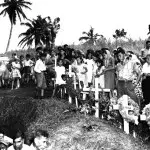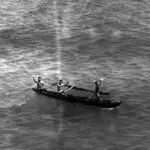War Atrocities: Tinta and Faha Massacres, Malesso
Table of Contents
Share This
Acts of desperation in Malesso'/Merizo
On July 15 and 16, 1944, with the American forces approaching Guam near the end of the Japanese occupation of the island in World War II, Japanese soldiers massacred nearly fifty Chamorro men and women from Malesso’ in two separate confrontations in the Tinta and Faha areas just outside the village of Malesso’.
The massacres are significant not only because of the tragedy of the two events, but because they led directly to a rebellion of the Malesso’ people in which they attacked and killed nearly all the Japanese soldiers in the area, thus liberating themselves.
The Tinta and Faha massacres are two of a number of such atrocities that occurred at the very end of the Japanese occupation period. Other such events include the Fena Caves massacre, and torture and murders at Yigo, Ta’i, and Manenggon.
On 15 July 1944, the 800 or so Malesso’ residents were rounded up and taken by soldiers to the Geus River Valley. The Japanese commander of the area read aloud the names of the most influential citizens of the southern village, which included twenty-five men and five women who were school teachers, the village commissioner, parents of sons in the US military, a mother who refused to bow to the Japanese and her two daughters, and other rebellious Chamorros.
The thirty people were told they were going to be part of a work crew and were marched to a cave in the Tinta area to rest and spend the night. Soon after they went into the cave, the soldiers tossed hand grenades through the opening, killing many of the Chamorros. The Japanese soldiers then took swords and bayonets and began stabbing anyone still alive. Still, by pretending to be dead, fourteen of the Chamorros survived.
The Chamorros at the Faha area were not as lucky. On 16 July, with almost identical circumstances, another group of men were marched to Faha. The exact details are not known, but it is speculated that the Japanese again used machine guns, grenades, and bayonets.
None of the Faha victims survived. It wasn’t until days later that the Malesso’ villagers learned the full extent of the massacre. Thirty men who were considered some of the tallest and strongest villagers had been killed.
Malesso' men rebel
When the Malesso’ people learned of the massacres, they were outraged. On 20 July, in broad daylight, a group of Malesso’ men stormed the Japanese quarters at Atate (another area of the village) and killed ten Japanese soldiers. Only one Japanese soldier escaped, fleeing towards the neighboring village of Inalåhan.
In April 1948, the victims of the Tinta and Faha cave massacres were memorialized with a monument listing their names on a bronze plaque. The memorial still stands near the shore of Malesso’.
For further reading
Farrell, Don A. The Pictorial History of Guam: Liberation, 1944. Tamuning: Micronesian Productions, 1984.
Guam War Survivors. “Home.” Last modified 27 June 2021.
Palomo, Tony. An Island in Agony. Self-published, 1984.
Rogers, Robert. Destiny’s Landfall: A History of Guam. Honolulu: University of Hawai’i Press, 1995.
Know my island - Know my history
- Acfalle, Fausto Chargualaf
- Acfalle, Vicente Reyes
- Aguigui, Felis Tyquiengco
- Babauta, Juan Cruz
- Baza, Maria Baza
- Baza, Rosa Tiajeron
- Champaco, Vicente Acfalle
- Charfauros, Arthur Benedict Lujan
- Cruz, Ramon Padilla
- Garrido, Jesus
- Garrido, Ramon Garrido
- Leon Guerrero, Jesus Garrido
- Lujan, Juan Espinosa
- Manalisay, Prudencio Acfalle
- Meno, Jose Meno
- Mesa, Maria Lukban
- Quitugua, Pedro Charguane
- Acfalle, Jose B. (deceased)
- Anderson, Francisco G. (deceased)
- Anderson, Jesus C. (deceased)
- Barcinas, Joaquin C. (deceased)
- Charfauros, Manuel T. (deceased)
- Concepcion, Joaquina E. (deceased)
- Cruz, Felipe S. (deceased)
- Cruz, Tomas E. (deceased)
- Garrido, Ramon C. (deceased)
- Leon Guerrero, Jose G. (deceased)
- San Nicolas, Juan C. (deceased)
- Santos, Luisa Baza (deceased)
- Soriano, Ignacio M. (deceased)
- Tajalle, Tomas T. (deceased)
- Acfalle, Juan Champaco
- Acfalle, Miguel Manalisay
- Aguon, Pedro Chargualaf
- Barcinas, Jose Tyquiengco
- Champaco, Jose Eguiguan
- Chargualaf, Cresencio Meno
- Cruz, Antonio Cruz
- Cruz, Cristobal Leon Guerrero
- Cruz, Joaquin Reyes
- Cruz, Jose Cruz
- Espinosa, Jose Tyquiengco
- Fegurgur, Antonio Champaco
- Garrido, Ignacio Chargualaf
- Garrido, Tomas Sablan
- Garrido, Vicente Chargualaf
- Guzman, Juan Concepcion
- Manibusan, Jose Manibusan
- Mansapit, Jesus Maguadog
- Mansapit, Santiago Naputi
- Mata, Vicente Manalisay
- Meno, Dometro Quinene
- Meno, Filipe Meno
- Meno, Pedro Chargualaf
- Quidagua, Jose Charguane
- Quidagua, Vicente Charguane
- Quinene, Vicente Reyes
- Taijeron, Antonio Soriano
- Taijeron, Juan Soriano
- Topasna, Juan Inocencio
- Tyquiengco, Francisco Babauta
- Chargualof, Nicolas A. (deceased)
- Meno, Vicente M. (deceased)
- Nangauta, Jose N. (deceased)
- Nangauta, Marion N. (deceased)
- Naputi, Juan A. (deceased)
- Taijeron, Patricio S. (deceased)



